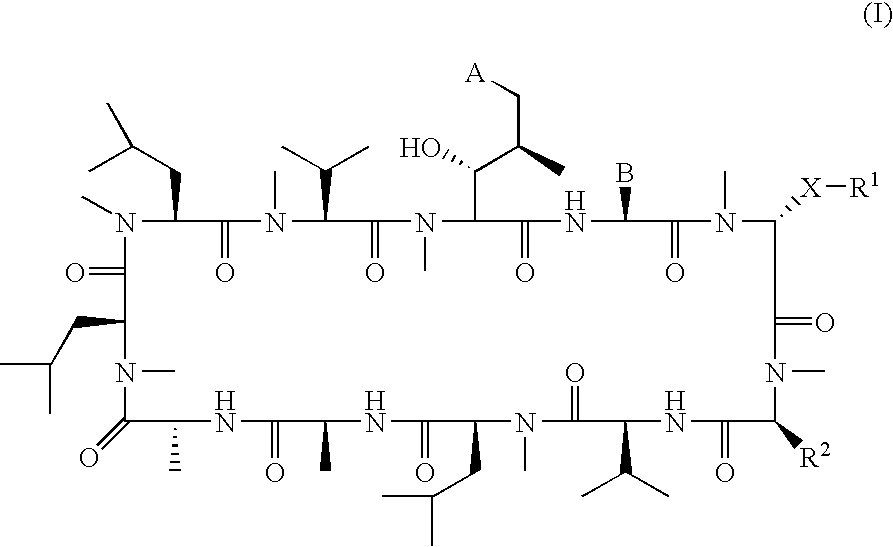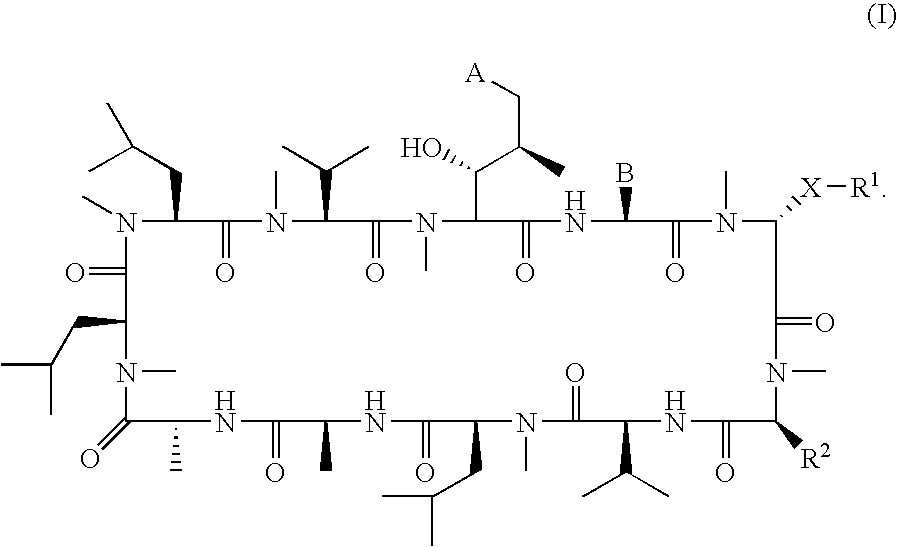Arylalkyl and Heteroarylalkyl Derivaties of Cyclosporine a for the Treatment and Prevention of Viral Infection
- Summary
- Abstract
- Description
- Claims
- Application Information
AI Technical Summary
Benefits of technology
Problems solved by technology
Method used
Image
Examples
example 1
3-Benzyloxycyclosporin
[0243]A solution of 3-(mercaptobenzthiazol-2-ylthio)cyclosporin (0.38 g, 0.28 mmol) and camphor sulfonic acid (0.1 g, 0.43 mmol) in dry tetrahydrofuran and dry benzyl alcohol (0.3 mL, 2.8 mmol) was heated at 50° C. for 10 hours. The mixture was allowed to cool to room temperature and mixed with saturated sodium bicarbonate, ether, and water. The layers were separated, and the aqueous phase extracted with diethyl ether. The combined organic extracts were dried over anhydrous magnesium sulfate, filtered and evaporated to dryness. Repeated chromatography on silica gel eluting with a mixture of dichloromethane and ethyl acetate yielded 64 mg of 3-benzyloxycyclosporin (Compound B). NMR signals for this compound in deuterochloroform are at 5.87 ppm (sarcosine H).
reference example 1
3-(Mercaptobenzthiazol-2-ylthio)cyclosporin
[0244]To a solution of lithium diisopropylamide (LDA) (10.0 mmol) in dry tetrahydrofuran at −70° C. under an inert atmosphere was added, drop wise, a solution of cyclosporin A (1.2 g, 1.0 mmol) in dry tetrahydrofuran, stirring was continued at −70° C. for 1 hour, after this time solid bis-benzothiazole disulfide (5 g, 15 mmol) was added in one portion. The resultant suspension was allowed to warm to room temperature and stirred for 18 hours. The mixture was filtered and the filtrate treated with water and evaporated to dryness. The residue was dissolved in ethyl acetate and washed with brine, dried over anhydrous magnesium sulfate, filtered and evaporated to dryness. The resultant brown gum (3.3 g) was purified by silica gel chromatography eluting with ethyl acetate / isohexane to yield 3-(mercaptobenzthiazol-2-ylthio)cyclosporin as a beige solid (0.33 g). NMR signals for this compound in deuterochloroform are at 6.98 ppm (sarcosine H).
example 3
Benzylthiocyclosporin
[0245]To a solution of lithium diisopropylamide IDA) (15.0 mmol) in dry tetrahydrofuran at −78° C. under an inert atmosphere was added, drop wise, a solution of cyclosporin A (1.2 g, 1.0 mmol) in dry tetrahydrofuran, stirring was continued at −78° C. for 1 hour. n-Butyllithium (6.0 mmol) was added and the reaction mixture was stirred at −78° C. for 40 min; after this time solid dibenzyl disulfide (3.7 g, 15 mmol) was added in one portion. The resultant mixture was allowed to warm to room temperature with stirring for 18 hours, and then treated with water and evaporated to dryness. The residue was dissolved in ethyl acetate and washed with brine, dried over anhydrous magnesium sulfate, filtered and evaporated to dryness. The resultant residue was purified by silica gel chromatography eluting with ethyl acetate / isohexane to yield 0.15 g of 3-benzylthiocyclosporin (Compound A). NMR signals for this compound in deuterochloroform are at 5.63 ppm (sarcosine H).
3-Aryl...
PUM
| Property | Measurement | Unit |
|---|---|---|
| Fraction | aaaaa | aaaaa |
| Fraction | aaaaa | aaaaa |
| Fraction | aaaaa | aaaaa |
Abstract
Description
Claims
Application Information
 Login to View More
Login to View More - R&D Engineer
- R&D Manager
- IP Professional
- Industry Leading Data Capabilities
- Powerful AI technology
- Patent DNA Extraction
Browse by: Latest US Patents, China's latest patents, Technical Efficacy Thesaurus, Application Domain, Technology Topic, Popular Technical Reports.
© 2024 PatSnap. All rights reserved.Legal|Privacy policy|Modern Slavery Act Transparency Statement|Sitemap|About US| Contact US: help@patsnap.com










